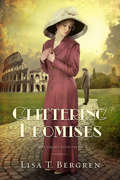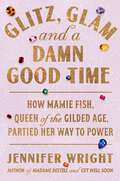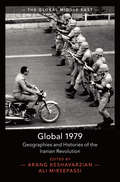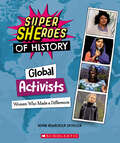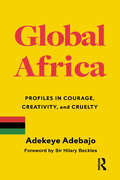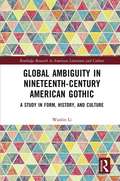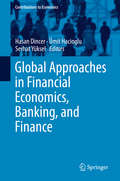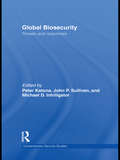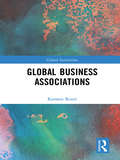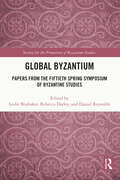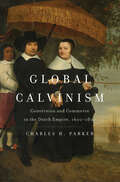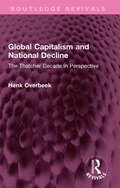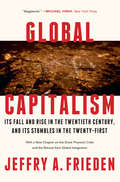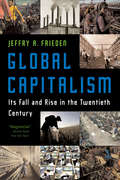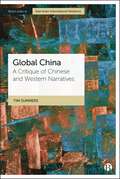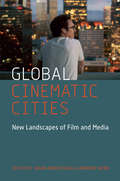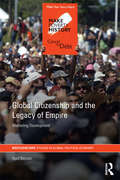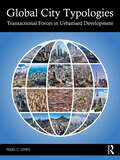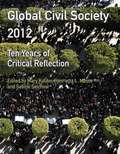- Table View
- List View
Glittering Promises
by Lisa T. BergrenWealth cannot buy peace ... or direction. For Cora Kensington, the Grand Tour was to be the trip of a lifetime. She discovered the family she never knew she had, and may have even found the love she longs for in Will. And yet her life has just become infinitely more challenging ... Hounded by journalists chasing the beguiling story of the newest American heiress, Cora fights to remain true to her past, reconcile her present, and still embrace her future. But as Will struggles with her newfound wealth, she begins to wonder if their love is strong enough to withstand all that threatens to pull them apart. Complicating matters is the stubborn pursuit of Pierre de Richelieu and the increased demands on her time and attention. Cora must stand up for what she believes--regardless of how that might challenge current family and cultural norms--in order to remain true to who she really is. And as she glimpses the end of the tour, Cora knows it's time to decide Who and what defines her ... and who and what does not.
Glitz, Glam, and a Damn Good Time: How Mamie Fish, Queen of the Gilded Age, Partied Her Way to Power
by Jennifer WrightFrom the author of Madame Restell and Get Well Soon, a biography of Mamie Fish that explores how women used parties and social gatherings to gain power and prestige. Marion Graves Anthon Fish, known by the nicknames &“Mamie&” and &“The Fun-Maker,&” threw the most epic parties in American history. This Gilded Age icon brought it all: lavish decor; A-list invitees; booze; pranks; and large animal guest stars. If you were a member of New York high society in the Peak Age of Innocence Era, you simply had to be on Mamie Fish&’s guest list. Mamie Fish understood that people didn&’t just need the formality of prior generations — they needed wit and whimsy. Make no mistake, however: Mamie Fish&’s story is about so much more than partying. In Glitz, Glam, and a Damn Good Time, readers will learn all about how Fish and her friends shaped the line of history, exerting their influence on business, politics, family relationships, and social change through elaborate social gatherings. In a time when women couldn&’t even own property, let alone run for office, if women wanted any of the things men got outside the home—glory, money, attention, social networking, leadership roles—they had to do it by throwing a decadent soiree or chairing a cotillion. To ensure people would hear and remember what she had to say, Mamie Fish lived her whole life at Volume 10, becoming famous not by playing the part of a saintly helpmeet, but by letting her demanding, bitchy, hilarious, dramatic freak flag fly. It's time to let modern readers in on the fun, the fabulousness, and the absolute ferocity that is Ms. Stuyvesant Fish—and her inimitable legacy.
Global 1979: Geographies and Histories of the Iranian Revolution (The Global Middle East #18)
by Ali Mirsepassi Arang KeshavarzianThe Iranian revolution of 1979 not only had an impact on regional and international affairs, but was made possible by the world and time in which it unfolded. This multi-disciplinary volume presents this revolution within its transnational and global contexts. Moving deftly from the personal to the global and from the provincial to the national, it draws attention to the multiplicity of spaces of the revolution such as streets, schools, prisons, personal lives, and histories such as the Cold War and Global 1960s and 70s. With a broad range of approaches, Global 1979 conceives of the Iranian Revolution not as exceptional or anachronistic, but as an uprising constituted by multiple, interwoven geographies and histories, which disrupt static and bounded notions of the local, national, regional, and global.
Global Activists: Women Who Made a Difference (Super SHEroes of History)
by Devra Newberger SperegenMeet the Super SHEroes of History, the women who have shaped history and society since ancient times.Greta Thunberg was only fifteen years old when she started School Strike for Climate in Sweden. Today, she leads a global opposition to climate change. Activist Wangari Maathai promoted the planting of 51 million trees in her native Kenya. Read about the bravery and courage of these and more women who have taken a stand against exploitation, poverty, and environmental destruction. They range from missionaries, academics, and writers to figureheads who keep their campaigns in the public eye and on the political agenda. This book tells their stories and describes their vital contributions.ABOUT THIS SERIES:From leading warriors into battle in Tang China to fighting for Civil Rights, exploring the deserts of Asia, and standing up for Indigenous peoples around the world, women have shaped history and society since ancient times. Often, however, their achievements went unrecognized. With lively text, compelling photography, and art, Super SHEroes of History brings herstory to life, illuminating the achievements of remarkable women from all backgrounds and all periods of time. The aim of this four-book series is to bring their inspiring stories to young readers — and to use engaging interactive prompts and questions to persuade them that anyone can grow up to change the world!
Global Africa: Profiles in Courage, Creativity, and Cruelty
by Adekeye AdebajoThis book of 100 essays written over the last three post-apartheid decades provides profiles of pan-African figures, mostly from Africa and its diaspora in the Americas, Europe, and the Caribbean. It covers the most important figures of “Global Africa” — and some important non-African personalities — encompassing diverse historical and political figures, technocrats, activists, writers, public intellectuals, musical and film artists, and sporting figures. These include: Cecil Rhodes, Kwame Nkrumah, Nelson Mandela, Thabo Mbeki, Mobutu Sese Seko, Idi Amin, Barack Obama, Margaret Thatcher, Boutros Boutros-Ghali, Kofi Annan, Ngozi Okonjo-Iweala, Nkosazana Dlamini-Zuma, Adebayo Adedeji, Martin Luther King Jr., Wangari Maathai, Ruth First, Chinua Achebe, Wole Soyinka, James Baldwin, Maya Angelou, Toni Morrison, Bell Hooks, Buchi Emecheta, Ali Mazrui, Edward Said, Angela Davis, Fela Anikulapo-Kuti, Bob Marley, Michael Jackson, Burna Boy, Asa, Muhammad Ali, Pelé, Eusébio, Diego Maradona, Viv Richards, Jonah Lomu, Hakeem Olajuwon, and many others. Print edition not for sale in Sub-Saharan Africa.
Global Ambiguity in Nineteenth-Century American Gothic: A Study in Form, History, and Culture (Routledge Research in American Literature and Culture)
by Wanlin LiAs part of a larger attempt to understand the dynamic interactions between gothic form and ideology, this volume focuses on a strong formal feature of the American gothic, "global ambiguity," and examines the important cultural work it performs in the nineteenth-century history of the genre. The author defines "global ambiguity" as occurring in texts whose internal evidence supports equally plausible and yet mutually exclusive interpretations. Combining insights from narrative theory and cultural studies, she investigates the narrative origin of global ambiguity and the ways in which it produces culturally meaningful readings. Canonical works and obscure ones from American gothic authors such as Charles Brockden Brown, Edgar Allan Poe, Nathaniel Hawthorne, Herman Melville, Louisa May Alcott, and Henry James are reexamined. This study reveals that the nineteenth-century American gothicists developed the gothic into an aesthetically sophisticated mode that engaged intensely with the pressing problems of American society, including moral citizenship, slavery, and the social status of women, and reimagined social realities in politically constructive manners. Literary scholars, students, and general readers interested in gothic literature, American literature, or narrative theory will find this book informative and inspiring.
Global Americans: Vol 1: To 1877
by Lon Kurashige Maria E. Montoya Carl J. Guarneri Laura A. Belmonte Steven W. Hackel Ellen Hartigan-O’ConnorGLOBAL AMERICANS speaks to an increasingly diverse population of students who seek to understand the place of the United States in a shifting global, social, cultural, and political landscape. America’s national experience and collective history have always been subject to transnational forces and affected by global events and conditions. In recognition of this reality, this insightful new text presents a history of North America and then the United States in which world events and processes are central rather than colorful sidelights. The narrative recovers the global aspects of America’s past and helps students understand the origins of the interconnected world in which they live. By weaving together stories, analysis, interpretation, visual imagery, and primary sources from across time and place, this book presents a revised history that reflects America’s -- and Americans’ -- relationship to events and peoples across the continent and beyond.
Global Approaches in Financial Economics, Banking, and Finance (Contributions to Economics)
by Hasan Dincer Ümit Hacioglu Serhat YükselThis volume discusses the impact of Financial Economics, Growth Dynamics, and the Finance & Banking sector in the economies of countries. The contributors analyse and discuss the effects of the recent financial crises on the economic growth and performance in various countries. The volume covers aspects like foreign borrowing, impact on productivity and debt crises that are strongly affected by the financial volatility of recent years and includes examples from Europe and Asia. In addition, the authors give particular attention to the private sector of Finance and Banking, which is deeply interwoven with the financial performance of a country’s economy. Examples such as bank profitability and troubled loans are covered and the volume also discusses the economic impact of banks such as the Ottoman Bank in a national economy. The book also explores the importance of financial stability, intellectual capital and bank performance for a stable economic environment.
Global Biosecurity: Threats and Responses (Contemporary Security Studies)
by Peter KatonaThis book explores a range of biohealth and biosecurity threats, places them in context, and offers responses and solutions from global and local, networked and pyramidal, as well as specialized and interdisciplinary perspectives. Specifically covering bioterrorism, emerging infectious diseases, pandemic disease preparedness and remediation, agroterroism, food safety, and environmental issues, the contributors demonstrate that to counter terrorism of any kind, a global, networked, and multidisciplinary approach is essential. To be successful in biosecurity, this book argues it is necessary to extend partnerships, cooperation, and co-ordination between public health, clinical medicine, private business, law enforcement and other agencies locally, nationally and internationally. Internationally, a clear understanding is needed of what has happened in past epidemics and what was accomplished in past bioprograms (in Britain, South Africa, Russia, for example). This book also assesses how, with the right technology and motivation, both a state and a non-state actor could initiate an extremely credible biothreat to security at both local and national levels. This book will be of much interest to students, researchers and practitioners of security studies, public health, public policy and IR in general. Peter Katona is Associate Professor of Clinical Medicine at the David Geffen School of Medicine at UCLA in Infectious Diseases. He is co-founder of Biological Threat Mitigation, a bioterror consulting firm. John P. Sullivan is a lieutenant with the Los Angeles Sheriff’s Department. He is also a researcher focusing on terrorism, conflict disaster, intelligence studies, and urban operations. He is co-founder of the Los Angeles Terrorism Early Warning (TEW) Group. Michael D. Intriligator is Professor of Economics at the University of California, Los Angeles (UCLA). He is also Professor of Political Science, Professor of Public Policy in the School of Public Policy and Social Research, and Co-Director of the Jacob Marschak Interdisciplinary Colloquium on Mathematics in the Behavioral Sciences, all at UCLA.
Global Bollywood
by Anandam P. Kavoori Aswin PunathambekarBollywood is one of the most prolific film industries in the world. Based in Mumbai (formerly Bombay), the industry churns out hundreds of films each year--primarily melodramatic films with music and elaborately choreographed dance routines. Bollywood's popularity is quickly spreading across the globe, and, beyond the films themselves, Bollywood has made its way into global popular culture. Global Bollywood brings together leading scholars to examine the transnational and transmedia terrain of Bollywood. Defining Bollywood as an arena of public culture distinct from Hindi-language Bombay cinema, this volume offers a new critical framework for analyzing the institutional, cultural, and political dimensions of Bollywood films and film music as they begin to constitute an important circuit of global flows in the twenty-first century. Organized thematically, the book examines contestations surrounding the term "Bollywood," changing relations between the state and the film industry, convergence with television and new media, online fan culture, film journalism, and the reception and negotiations of gender and sexuality in diverse socio-cultural contexts. Global Bollywood is indispensable for understanding not only Bollywood cinema and culture but also how global media flows are reconfiguring relationships among geography, cultural production, and cultural identity.
Global Bollywood: Travels of Hindi Song and Dance
by Sangita Gopal Sujata MoortiBollywood movies and their signature song-and-dance spectacles are an aesthetic familiar to people around the world, and Bollywood music now provides the rhythm for ads marketing goods such as computers and a beat for remixes and underground bands. These musical numbers have inspired scenes in Western films such as Vanity Fair and Moulin Rouge.Global Bollywood shows how this currency in popular culture and among diasporic communities marks only the latest phase of the genre&’s world travels. This interdisciplinary collection describes the many roots and routes of the Bollywood song-and-dance spectacle. Examining the reception of Bollywood music in places as diverse as Indonesia and Israel, the essays offer a stimulating redefinition of globalization, highlighting the cultural influence of Hindi film music from its origins early in the twentieth century to today.Contributors: Walter Armbrust, Oxford U; Anustup Basu, U of Illinois, Urbana-Champaign; Nilanjana Bhattacharjya, Colorado College; Edward K. Chan, Kennesaw State U; Bettina David, Hamburg U; Rajinder Dudrah, U of Manchester; Shanti Kumar, U of Texas, Austin; Monika Mehta, Binghamton U; Anna Morcom, Royal Holloway College; Ronie Parciack, Tel Aviv U; Biswarup Sen, U of Oregon; Sangita Shrestova; Richard Zumkhawala-Cook, Shippensburg U.Sangita Gopal is assistant professor of English at the University of Oregon. Sujata Moorti is professor of women&’s and gender studies at Middlebury College.
Global Brain Singularity: Universal History, Future Evolution and Humanity’s Dialectical Horizon (World-Systems Evolution and Global Futures)
by Cadell LastThis book introduces readers to global brain singularity through a logical meditation on the temporal dynamics of the universal process. Global brain singularity is conceived of as a future metasystem of human civilization that represents a qualitatively higher coherence of order.To better understand the potential of this phenomenon, the book begins with an overview of universal history. The focus then shifts to the structure of human systems, and the notion that contemporary global civilization must mediate the emergence of a commons that will transform the future of politics, economics and psychosocial life in general. In this context the book presents our species as biocultural evolutionary agents attempting to create a novel and independent domain of technocultural evolution that affords us new levels of freedom.Lastly, the book underscores the internal depths of the present moment, structured by a division between subject and object. The nature of the interaction between subject and object would appear to govern the mechanics of a spiritual process that is key to understanding the meaning of singularity inclusive of observers. Given its scope, the book will appeal to readers interested in systems approaches to the emerging world society, especially historians, philosophers and social scientists.
Global Burden of Armed Violence 2015
by GenevaThe 2015 edition of the Global Burden of Armed Violence provides a wealth of data relevant to security and the post-2015 sustainable development framework. It estimates that 508,000 people died violently - in both conflict and non-conflict settings - every year in 2007–12, down from 526,000 in 2004–09. This trend is visible in non-conflict settings, where the proportion of women and girls is also slightly reduced, from 17 to 16 per cent. Yet, the number of direct conflict deaths is on the rise: from 55,000 to 70,000 per year over the same periods. Firearms are used in close to half of all homicides committed and in almost one-third of direct conflict deaths. Nearly USD 2 trillion in global homicide-related economic losses could have been saved if the homicide rate in 2000–10 had been reduced to the lowest practically attainable levels - between 2 and 3 deaths per 100,000 population.
Global Business Associations (Global Institutions)
by Karsten RonitGlobal business tends to be perceived as a number of individual but powerful multinational corporations, capable of controlling markets and influencing political decisions; in fact, global business is highly organized through a plethora of associations that bring together competing companies and conflicting national businesses. Indeed, global business associations have a long history and, with accelerated globalization, further opportunities emerge for unified business action. This book fills a significant gap in the current literature, examining the pivotal role of global business associations and providing a concise and accessible overview of their different functions in a range of institutional contexts. Beginning by clarifying the concept of global business associations, the author puts their role into a historical and contemporary context in which their economic, social and political functions are sketched. Their historical origin is outlined, including the proliferation of global associations in the twentieth and twenty-first centuries. He then moves on to explore and analyse the different types of actors, explaining key categories and their place in the organization of global business with chapters on peak associations (e.g. ICC and WEF), industry associations, alliances, as well as clubs and think tanks, and facilitators. Covering the history, current role and future evolution of this dynamic category of associations, this work will be essential reading for students and scholars of international political economy, international relations, international organizations and global governance.
Global Byzantium: Papers from the Fiftieth Spring Symposium of Byzantine Studies (Publications of the Society for the Promotion of Byzantine Studies #24)
by Daniel Reynolds Leslie Brubaker Rebecca DarleyGlobal Byzantium is, in part, a recasting and expansion of the old ‘Byzantium and its neighbours’ theme with, however, a methodological twist away from the resolutely political and toward the cultural and economic. A second thing that Global Byzantium – as a concept – explicitly endorses is comparative methodology. Global Byzantium needs also to address three further issues: cultural capital, the importance of the local, and the empire’s strategic geographical location. Cultural capital: in past decades it was fashionable to define Byzantium as culturally superior to western Christian Europe, and Byzantine influence was a key concept, especially in art historical circles. This concept has been increasingly criticised, and what we now see emerging is a comparative methodology that relies on the concept of ‘competitive sharing’, not blind copying but rather competitive appropriation. The importance of the local is equally critical. We need to talk more about what the Byzantines saw when they ‘looked out’, and what others saw in Byzantium when they ‘looked in’ and to think about how that impacted on our, very post-modern, concepts of globalism. Finally, we need to think about the empire’s strategic geographical position: between the fourth and the thirteenth centuries, if anyone was travelling internationally, they had to travel across (or along the coasts of) the Byzantine Empire. Byzantium was thus a crucial intermediary, for good or for ill, between Europe, Africa, and Asia – effectively, the glue that held the Christian world together, and it was also a critical transit point between the various Islamic polities and the Christian world.
Global Calvinism: Conversion and Commerce in the Dutch Empire, 1600-1800
by Charles H. ParkerA comprehensive study of the connection between Calvinist missions and Dutch imperial expansion during the early modern period &“A tour de force offering the reader the best study of global Calvinism in the realms of the Dutch East India Company.&”—Ronnie Po-Chia Hsia, editor, Calvinism and Religious Toleration in the Dutch Golden Age Calvinism went global in the seventeenth and eighteenth centuries, as close to a thousand Dutch Reformed ministers, along with hundreds of lay chaplains, attached themselves to the Dutch East India and West India companies. Across Asia, Africa, and the Americas where the trading companies set up operation, Dutch ministers sought to convert &“pagans,&” &“Moors,&” Jews, and Catholics and to spread the cultural influence of Protestant Christianity. As Dutch ministers labored under the auspices of the trading companies, the missionary project coalesced, sometimes grudgingly but often readily, with empire building and mercantile capitalism. Simultaneously, Calvinism became entangled with societies around the world as encounters with indigenous societies shaped the development of European religious and intellectual history. Though historians have traditionally treated the Protestant and European expansion as unrelated developments, the global reach of Dutch Calvinism offers a unique opportunity to understand the intermingling of a Protestant faith, commerce, and empire.
Global Capitalism and National Decline: The Thatcher Decade in Perspective (Routledge Revivals)
by Henk OverbeekFirst published in 1990, Global Capitalism and National Decline is a major contribution to the study of British political and economic decline. The author concentrates on the global nature of capitalism as the context for the development of national capitalism, and on the relationship between internal and external factors. A long-term view of British politics enables him to demonstrate that competing popular explanations of Britain’s crisis and the rise of Thatcherism in response to it, are in fact interconnected. The long decline of Britain originating in the 19th century, the inherent weakness of the post-1945 settlement, and the critical events of 1970s, acquire their fullest meaning when seen as different ‘layers’ of one and the same historical process. Henk Overbeek takes the story of Britain’s decline through to Margaret Thatcher’s tenth anniversary in office. His book will be invaluable to scholars and students of economics, politics, and history. it offers a clear perspective on the problems of national decline within a global context, and on Britain’s position in Europe and in the wider world.
Global Capitalism: Its Fall And Rise In The Twentieth Century
by Jeffry A. Frieden"One of the most comprehensive histories of modern capitalism yet written." —Michael Hirsh, New York Times An authoritative, insightful, and highly readable history of the twentieth-century global economy, updated with a new chapter on the early decades of the new century. Global Capitalism guides the reader from the globalization of the early twentieth century and its swift collapse in the crises of 1914–45, to the return to global integration at the end of the century, and the subsequent retreat in the wake of the financial crisis of 2008.
Global Capitalism: Its Fall and Rise in the Twentieth Century
by Jeffry A. FriedenIn 1900 international trade reached unprecedented levels and the world's economies were more open to one another than ever before. Then as now, many people considered globalization to be inevitable and irreversible. Yet the entire edifice collapsed in a few months in 1914. Globalization is a choice, not a fact. It is a result of policy decisions and the politics that shape them. Jeffry A. Frieden's insightful history explores the golden age of globalization during the early years of the century, its swift collapse in the crises of 1914-45, the divisions of the Cold War world, and the turn again toward global integration at the end of the century. His history is full of character and event, as entertaining as it is enlightening.
Global China: A Critique of Chinese and Western Narratives (Bristol Studies in East Asian International Relations)
by Tim SummersThis insightful book explores evolving perceptions of China, contrasting dominant Western narratives with Chinese perspectives. Highlighting the complexities of these discourses, the book critiques three prevailing views of China’s rise: the return of geopolitics, challenges to liberal order and prospects for collaborative governance. Bridging China Studies, International Relations and Global Political Economy, the book examines the politics of knowledge production to present a nuanced understanding of China. It argues for viewing China as a distinctive yet interconnected global power whose development reflects a dialectical relationship with existing global systems. It is essential reading for understanding China’s role in today’s shifting global political landscape.
Global Cinematic Cities: New Landscapes of Film and Media
by Lawrence Webb Andersson JohanCinema and audiovisual media are integral to the culture, economy and social experience of the contemporary global city. But how has the relationship between cinema and the urban environment evolved in the era of digital technology, new media and globalization? And what are the critical tools and concepts with which we can grasp this vital interconnection between space and screen, viewer and built environment? Engaging with a rapidly transforming urban world, the contributions to this collection rethink the 'cinematic city' at a global scale. By presenting a global constellation of screen cities within one volume, the book encourages juxtapositions and comparisons across the North and South to capture the global city and its dynamics of exchange, hybridity, and circulation. The contributions examine film and screen cultures in a range of locations spanning five continents: Antibes, Beijing, Buenos Aires, Busan, Cairo, Caracas, Copenhagen, Jakarta, Kolkata, Lagos, Los Angeles, Malmö, Manila, Mumbai, Nairobi, Paris, Seoul, Sète, and Shanghai. The chapters address topics that range across the contemporary film and media landscape, from popular cinema, art cinema, and film festivals to serial television, public screens, multimedia installations, and video art. Contributors: Chris Berry, Yomi Braester, Jinhee Choi, Pei-Sze Chow, Thomas Elsaesser, Malini Guha, Jonathan Haynes, Will Higbee, Igor Krstic, Christian B. Long, Joanna Page, Lawrence Webb.
Global Cinematic Cities: New Landscapes of Film and Media
by Johan Andersson Lawrence WebbCapturing a rapidly transforming urban world, this collection investigates the emerging dynamics between filmmaking and urban change on a global scale. It surveys film, media and screen cultures in Buenos Aires, Beijing, Berlin, Cairo, Copenhagen, Delhi, Kolkata, Lagos, Los Angeles, Malmö, Manila, Paris, Rome, and Shanghai. Drawing on work in film and urban studies, the volume innovatively rethinks the "cinematic city" and argues for its ongoing relevance. Film festivals, transnational production, public screens, media ecologies, nostalgia, cinephilia, infrastructure, and informal economies illuminate the juxtaposition of cinema and urban space. Works covered include The Bourne Legacy (2012), Her (2013), Medianeras (2011), Last Flight to Abuja (2012), Maach, Mishti, and More (2013), The Future of the Past (2012), Good Morning Aman (2009), Couscous (2007), the transnational television production The Bridge, and Chinese video art.
Global Citizenship and the Legacy of Empire: Marketing Development (RIPE Series in Global Political Economy)
by April BiccumThis book investigates the parallels between mainstream development discourse and colonial discourse as theorized in the work of Homi Bhabha, Gayatri Spivak and Edward Said. Aiming to repoliticize post-colonial theory by applying its understandings to contemporary political discourses, author April Biccum critically examines the ways in which development in its current form has recently begun to be promoted among the metropolitan public. Biccum contends that what has begun is a sustained marketing campaign for development that is a repetition, augmentation and ultimately much greater success of the work of the Empire Marketing Board of 1926. Demonstrating how this marketing campaign for development attempts to facilitate support for neo-liberal globalization, Biccum contends that this theatre of legitimation is emerging in response to growing critical voices and counter-hegemonic activity on the international stage. Featuring in depth analyses of the UK, cultural values, DfID, the commemoration of the slave trade and campaigns including Live8 and Make Poverty History, this book will be of interest to students and scholars of postcolonial studies, development studies, and international political economy. It will also offer insights valuable to a wider range of subjects including critical theory and globalization studies.
Global City Typologies: Transactional Forces in Urbanised Development
by Nigel C. LewisGlobal City Typologies explores the historical, cultural and socio-economic transactional forces in the development of existing cities through to newly planned and emerging cities. Individual chapters address different sets and typologies of global cities to analyse their comparative evolution and standing today. The separate parts and individual chapters have been grouped around 125 different established, planned and emerging cities and analysed according to different typologies and thematic categories that comprise historic cities, early trading cities, planned cities, emerging global cities, mega cities and megalopolitan agglomerations. These span five continents – including the industrial cities of Chicago and Manchester, new capitals such as Brasília and New Delhi, innovative cities such as Singapore and Tel Aviv and mega cities such as Mexico City. The book is fully illustrated throughout with modern and historical maps, which enables visualisation of the forces that have shaped ongoing development of these major global cities. This is an essential book for students and professionals in urban design and planning, administrators, economists, designers and developers.
Global Civil Society 2012
by Mary Kaldor Henrietta L. Moore Sabine SelchowActivists and academics look back over ten years of 'politics from below', and ask whether it is merely the critical gaze upon the concept that has changed or whether there is something genuinely new about the way in which civil society is now operating. "
